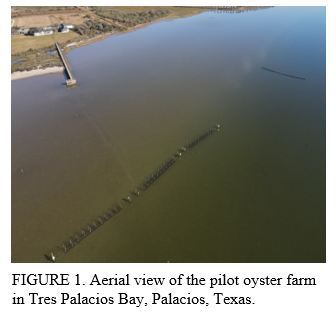INSTALLATION AND MANAGEMENT OF A SEMI-COMMERCIAL SCALE PILOT OYSTER FARM IN TRES PALACIOS BAY, PALACIOS, TEXAS
In 2019, commercial off-bottom oyster farming was legalized in Texas by House Bill 1300. Texas Parks and Wildlife Department (TPWD) approved regulations to create the framework for the industry in May 2020. To aid in facilitating a successful launch of this new industry, research was needed to evaluate the feasibility of oyster farming in Texas, determine best management practices for Texas bays, and to identify potential issues and their possible solutions. A semi-commercial scale pilot oyster farm was established in Tres Palacios Bay in Palacios, Texas to evaluate two types of oyster aquaculture methods, floating cages and an adjustable long-line system, for growing oysters in natural waters in Texas.
Before installing the farm, an appropriate site was selected based on water depth, bottom characteristics, salinity regime, and TPWD criteria to protect critical habitats such as seagrass, natural oyster reefs, and rookeries. After all permits for the site selected had been approved, installation of the farm began. The adjustable long-line system and floating cages used at the farm had different installation methods and each method had unique challenges. Some of these challenges included sourcing materials and finding contractors that could perform the installation and were willing to travel to remote sites. When installing the adjustable long-line system, different methods (water-jetting or pile-driving) and their pros and cons were considered.
Management of the farm included regular and seasonal gear maintenance, developing a seasonal desiccation regime to reduce biofouling, regular tumbling and grading of oysters, and dividing oysters to reduce densities as they grow. Hurricane protocols were also implemented several times throughout the season.
